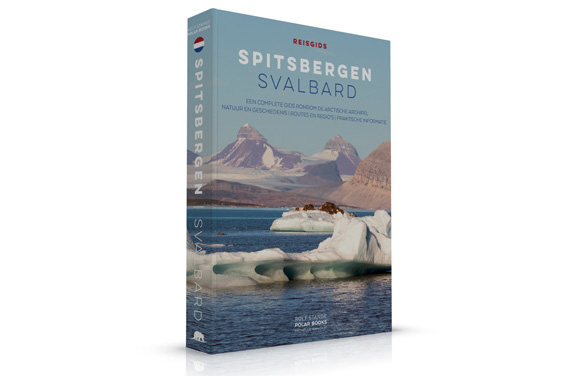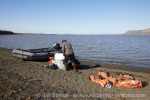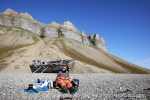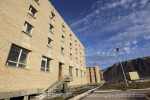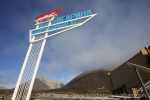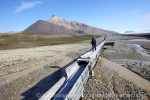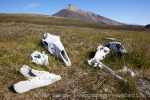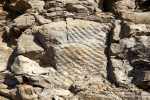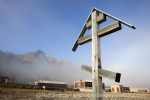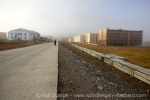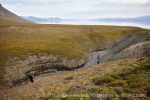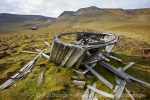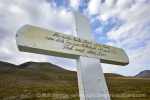-
current
recommendations- Liefdefjord
New page dedicated to one of Spitsbergen's most beautiful fjords. Background information and many photos.
- New Spitsbergen guidebook
The new edition of my Spitsbergen guidebook is out and available now!
- Liefdefjord
New page dedicated to one of Spitsbergen's most beautiful fjords. Background information and many photos.
Page Structure
-
Spitsbergen-News
- Select Month
- May 2025
- April 2025
- March 2025
- February 2025
- January 2025
- December 2024
- November 2024
- October 2024
- September 2024
- August 2024
- July 2024
- June 2024
- May 2024
- April 2024
- March 2024
- February 2024
- January 2024
- December 2023
- November 2023
- October 2023
- September 2023
- August 2023
- July 2023
- June 2023
- May 2023
- April 2023
- March 2023
- February 2023
- January 2023
- December 2022
- November 2022
- October 2022
- September 2022
- August 2022
- July 2022
- June 2022
- May 2022
- April 2022
- March 2022
- February 2022
- January 2022
- December 2021
- November 2021
- October 2021
- September 2021
- August 2021
- July 2021
- June 2021
- May 2021
- April 2021
- March 2021
- February 2021
- January 2021
- December 2020
- November 2020
- October 2020
- September 2020
- August 2020
- July 2020
- June 2020
- May 2020
- April 2020
- March 2020
- February 2020
- January 2020
- December 2019
- November 2019
- October 2019
- September 2019
- August 2019
- July 2019
- June 2019
- May 2019
- April 2019
- March 2019
- February 2019
- January 2019
- December 2018
- November 2018
- October 2018
- September 2018
- August 2018
- July 2018
- June 2018
- May 2018
- April 2018
- March 2018
- February 2018
- January 2018
- December 2017
- November 2017
- October 2017
- September 2017
- August 2017
- July 2017
- June 2017
- May 2017
- April 2017
- March 2017
- February 2017
- January 2017
- December 2016
- November 2016
- October 2016
- September 2016
- August 2016
- July 2016
- June 2016
- May 2016
- April 2016
- March 2016
- February 2016
- January 2016
- December 2015
- November 2015
- October 2015
- September 2015
- August 2015
- July 2015
- June 2015
- May 2015
- April 2015
- March 2015
- February 2015
- January 2015
- December 2014
- November 2014
- October 2014
- September 2014
- August 2014
- July 2014
- June 2014
- May 2014
- April 2014
- March 2014
- February 2014
- January 2014
- December 2013
- November 2013
- October 2013
- September 2013
- August 2013
- July 2013
- June 2013
- May 2013
- April 2013
- March 2013
- February 2013
- January 2013
- December 2012
- November 2012
- October 2012
- September 2012
- August 2012
- July 2012
- June 2012
- May 2012
- April 2012
- March 2012
- February 2012
- January 2012
- December 2011
- November 2011
- October 2011
- September 2011
- August 2011
- May 2011
- April 2011
- March 2011
- February 2011
- January 2011
- December 2010
- November 2010
- September 2010
- August 2010
- July 2010
- June 2010
- May 2010
- April 2010
- March 2010
- February 2010
- November 2009
- October 2009
- August 2009
- July 2009
- June 2009
- May 2009
- April 2009
- March 2009
- February 2009
- January 2009
- December 2008
- November 2008
- October 2008
- August 2008
- July 2008
- June 2008
- May 2008
- April 2008
- March 2008
- February 2008
- April 2000
- Select Month
-
weather information
-
Newsletter

| Guidebook: Spitsbergen-Svalbard |
Home →
Yearly Archives: 2020 − News & Stories
Guidebook “Spitsbergen-Svalbard” now available in Dutch
The guidebook “Spitsbergen-Svalbard” is now also available in Dutch!
In short words: here it is (click on the link to get to my webshop).
A more complete version of the story:
How come?
A couple of years ago in Tromsø – we were just about to set sail for Bear Island and Spitsbergen – Jonneke van Eijsden said it would be good to have the book in Dutch.
Initiative and main translator: Jonneke van Eijsden
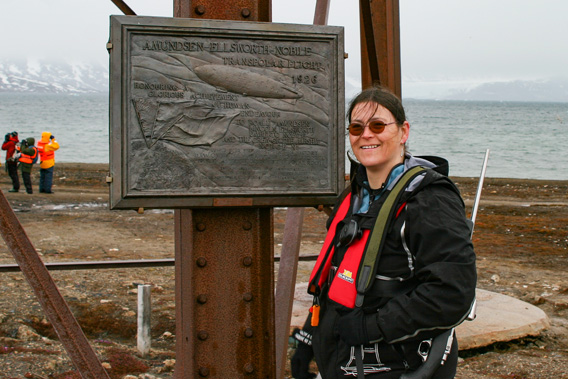
Initiative and main translator: Jonneke van Eijsden.
Sure, no doubt, I could agree on that. But the then ongoing Norwegian translation of the book had already brought me close to my limits in terms of time, money and nerves, so I was not really inclined to open up a new big project, so my slightly reserved reply was something like “fine, go ahead if you want to.”
And Jonneke went ahead and did it. The whole thing, from the table of contents to the appreciations in the end.
Quite unbelievable, isn’t it?
Much appreciated: help from friends and colleagues
But that was, of course, not all. People with solid knowledge of Dutch language and arctic terminology in various fields were needed to help the project on its way towars a book that could be printed. This group of good people included Marion den Bakker, Arjen Drost, Sarah Gerats, Regina Meijndert, Annette Scheepstra, Ronald van Belzen, Tom van Hoof and Ronald Visser. And highly knowledgeable people like Hans Beelen, Louis Beyens and Maarten Loonen, all acknowledged experts in their fields, alowed us to pick their brains.
And my old master Rinie van Meurs was so kind to contribute with a foreword!
A big “thank you” to all of you! This Dutch Spitsbergen guidebook would not exist without you!
Co-author: Michelle van Dijk
The Netherlands have got a long history in relation to Spitsbergen, starting with the discovery in 1596 during Willem Barentsz’ third voyage and the name. That led to a special perspective that is best understood and described from an inside perspective.
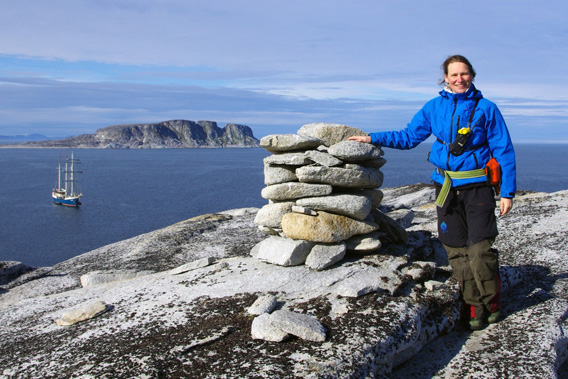
Co-author: Michelle van Dijk (on Foynøya). Photo © Birgit Lutz.
So this Dutch book has, for the first time in the by now quite long history of this book, two authors: Michelle van Dijk joined me in the role of co-author and added various sections such as one about Willem Barentsz, one about 17th century whaling, then the whole story of Barentsburg, Rijpsburg and NeSpico, Sjef van Dongen, local information about places such as Smeerenburg, … all Dutch chapters of the Dutch relationship to Spitsbergen (and, of course, not unmentioned in the other editions of the book, but Michelle wrote new versions of these sections, adding more detail and a new perspective). And of course she took off within her own field of knowledge and passion and wrote a new chapter about plants.
In other words, the new book is not just a mere translation of the pre-existing English and German versions (there is also a Norwegian one, but that was not used in the translation process), but a new book with content that the other editions don’t have, at least not as it is here. It won’t surprise that it is the thickest one of the whole family, with an impressie 656 pages.
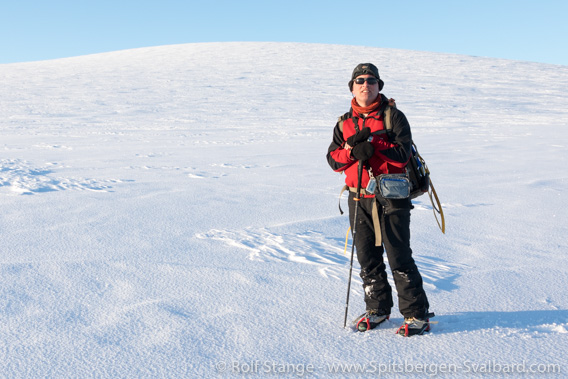
I am and remain the main author: Rolf Stange.
So, if you speak Dutch (or if you are interested anyway), click here and check it out! Orders can be placed from now and shipping will start soonest, as soon as we get the key rings in that will be shipped with the first 100 books (see below).
spitsbergengids.nl
With spitsbergengids.nl, Michelle has created a new site, dedicated to the Dutch guidebook. There you can, of course, also find Michelle’s other and own book, Sjef van Dongen – Nederlandse Poolhelt.
And an exclusive gift made in Longyearbyen with the first 100 orders
And on top of this: the first 100 orders that come in through my or Michelle’s webshop will be complemented by an exclusively made key ring made in Longyearbyen by master carpenter Wolfgang Zach, who is also the man behind the Spitsbergen driftwood picture frames and the kitchen slats. The key rings are made of two different kinds of wood, both with origins in Spitsbergen: the dark wood is from oak beams that were used in mine 7 to support the roof, and the polar bear is made from driftwood. We have got 100 of these key rings, exclusively made to come with the first 100 orders and, in this exact design, not available elsewhere!
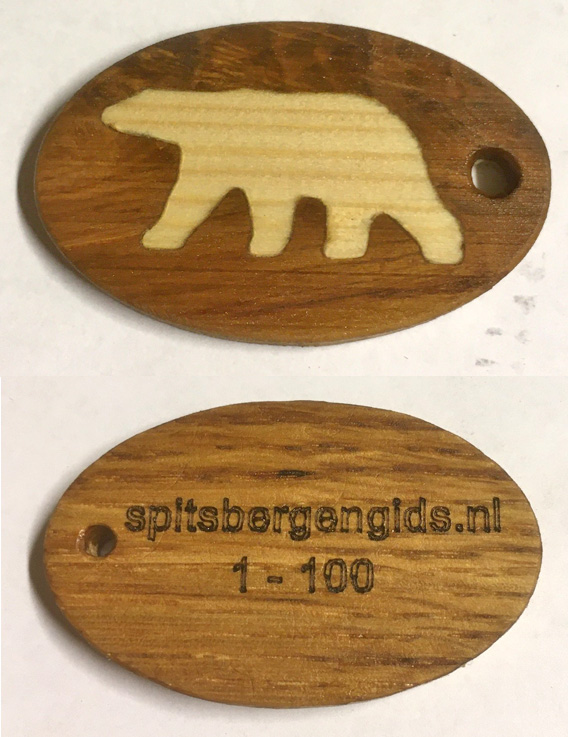
These beautiful key rings are made in Longyearbyen as an exclusive gift that comes with the first 100 copies of the Dutch Spitsbergen guidebook ordered individually through my webshop or Michelle’s 🙂
New page: Grønfjord – more than Barentsburg
A new page for the weekend! Most will know Grønfjord mainly as the place where Barentsburg is located. But it is actually a beautiful fjord with lovely scenery, interesting nature and good hiking opportunities in the summer as well as in the winter. Find background information about nature and history together with plenty of photos on the Grønfjord page which has just got a completely fresh overhaul – check it out!
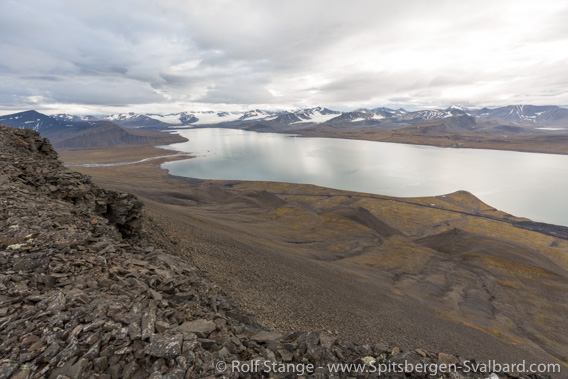
View from Grønfjordfjellet south of Barentsburg over the inner parts of Grønfjord.
One of many new photos on the overhauled Grønfjord page.
Quiet on the northern front – moving on behind the scene
Quiet on the northern front ..?
“Quiet on the northern front” is, of course, not entirely true. There is always something going on in Spitsbergen, but currently not much that would shake the world. The locals can still be happy about not having a single case of Corona/Covid 19 in Spitsbergen. Hurtigruten Svalbard considers to sell their local properties to a “serious investor” to rent their hotels etc. then on a long-term basis. I guess you have to have studied something other than geography to understand that kind of business model. The Sysselmannen will release 18 employees this year and replace them with new ones, mostly because the people have to return to their long-term engagements in mainland Norway if they want to keep them. Such as large turnover is, of course, not what anyone would want – the Sysselmannen has 45 positions in total, currently, so that is an exchange of staff of more than 30 %.
Polar bears and people have recently managed to keep a healthy distance from each other. Fortunately.
It’s things like that which are currently going on. Everything is important for some people, but it is not shaking the world.
New book projects on the way
The corona-year has, amongst others, resulted in more time at the office table than originally planned. A new book project has already more than 300 pages of text, another one is also making some progress. But many more pages will have to be written in both cases before anything will be ready for release. “New book project” is, of course, not entirely true. Both have been work in process for more than just a couple of months, to put it mildly. So there is something positive in having more time than planned.
New pages
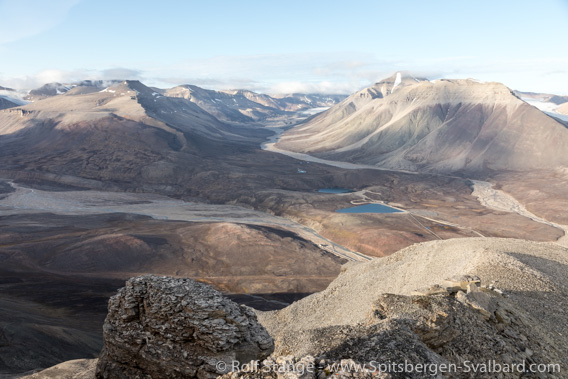
Landscape in central Dickson Land: view from Yggdrasilkampen
Illustration from the renewed page about Dickson Land and Billefjord.
Another thing that has taken up at least some speed is re-doing a number of pages within spitsbergen-svalbard.com. Many pages that I was proud of 10 years ago are getting a bit … well, old now. A number of pages have got new maps, illustrations, photo galleries and revised text as necessary. This includes pages about beautiful fjords that many of you will know, and pages about more unknown places that you can explore if you feel like travelling Spitsbergen online – the door is open, just come in, there is plenty of good stuff waiting!
- The renewed page about Dickson Land and Billefjord. One of the most beautiful and interesting parts of Spitsbergen, believe it or not! An area that certainly deserved something better than what I had in that place until a few days ago.
- The same can be said about the page about the area in outer Isfjord between Kapp Linné and Festningen.
- Kongsfjord Krossfjord used to be merged into one page until recently, an unbearable situation 🙂 now both of these beautiful and frequently visited fjords have got their own, improved page.
- There are, of course, also a couple of new panorama pages, dedicated to individual sites rather than larger areas (in contrast to the pages mentioned above), some of them with many images (both panorama and conventional photos) and a lot of background information, such as the page about Svenskehuset.
- The same is the case with the new page about Brucebyen, a lovely and very interesting place in Billefjord. I have a lot of fond memories from Brucebyen, but the new page is, of course, not about my own stories. It is rather about the history of the famous Scottish polar explorer William S. Bruce and his Scottish Spitsbergen Syndicate.
- What else do we have? Oh, of course, Collinsodden at the entrance of Krossfjord. That’s a place I bett most of you won’t have been to, but it is worth a visit, the scenery is not exactly what you would initially think of when you mentally picture Spitsbergen, but it is beautiful and there is, of course, an interesting little story connected to the place.
- And Wigdehlpynten in Woodfjord. Colours, colours … that is Christiane Ritter’s red desert sand.
… to be continued.
So there is plenty of reading material for one or two rainy autumn days or dark winter evenings. By the way, as you may have noticed, it comes not only completely free, but also without all the online ads popping up that you have on most other “free” websites, which gather a lot of your data and reduce the reading experience greatly in my opinion. That’s how other website owners make their money. Nothing like that on spitsbergen-svalbard.com. Not that economy didn’t play a role for me, obviously, and this years I would have more reason than at other times to tap that resource. But I don’t want to do that, because I like my website as it is and I want to keep it this way. If you want to support it – have a look at my webshop, there is a lot of good arctic books and fine other things that might give you (or someone you like) pleasure.
So … have a look at these new/renewed pages listed above. I greatly enjoyed making them and I hope they find your interest.
Spitsbergen-Svalbard: the guidebook – now coming up in Dutch
The guidebook Spitsbergen-Svalbard has been translated and it is now printed, soon it will be ready for shipping 🙂 another big project that has come to an end – well, not really, but the process of making the book in the first place. More about that soon.
National budget 2021: hundreds of millions for Spitsbergen
The Norwegian government has published the suggestions for the new national budget for 2021. The plans include several hundred million Norwegian kroner for Spitsbergen:
- The labour inspectore (Arbeitstilsynet) will be strengthened with one million kroner.
- The mining company Store Norske is to receive 40 millions to compensate for expected losses in mine 7, which is suffering from generally high costs and additional problems due to flooding with glacial meltwater after the hot summer days in July. The government aims at securing the supply of Longyearbyen’s coal power plant with local coal.
- 61.1 Millionen are needed for securing Longyearbyen against snow avalanches and river floods – both are very important issues for Longyearbyen.
- The comprehensive clean-up of Sveagruva and the nearby mines of Lunckefjellet and Svea Nord is expected to require 412.8 millions in 2021.
- Svalbardmuseum is in for a grant of 1.5 millions, to “strengthen the museum and stimulate more activity”, also in the light (or, rather, darkness) of the corona crisis.
- Also the Sysselmannen will get increased fundings, amongst others for to create a stilling for a lawyer to work tasks that a public prosecutor might otherwise take care of, when cases leave the Sysselmannen – an institution that includes the police – in Longyearbyen.
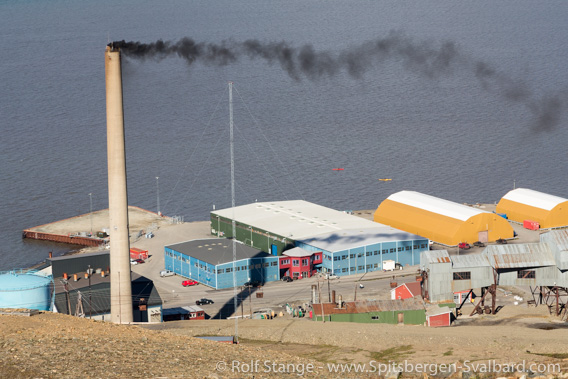
Longyearbyen has a lot of important issues to deal with and some of them will be taken important steps further with Oslo’s new budget for 2021. Getting a new power source on the way to replace the old coal power plant would certainly make sense, to mention just one of many problems that Longyearbyen needs to take care of.
The local tourism organisation Visit Svalbard was disappointed by getting an increase of only 100,000 kroner on top of the current budget of 3.05 millions. Visit Svalbard represents many local companies, all of which are hit hard by the corona crisis.
But community representatives expressed themselves mostly satisfied. Amongst others, Longyearbyen will now also get the opportunity to apply for fundings from “klimasats”, a public fund for for climate protection projects that was established for mainland communities already in 2016. Longyearbyen has very high per capita CO2 emissions and electricity is very expensive. A new solution might bring considerable improvement for both issues. Currently, a hydrogen-based solution is discussed. Hydrogen could be supplied from north Norway and is expected to reduce both CO2 emissions and the high prices for electricity significantly.
The government’s budget plans still need the parliament’s approval.
Isfjord is a high-arctic fjord again. For a while.
Less and thinner ice in the innermost branches of Isfjord such as Tempelfjord and Billefjord, and a solid ice-cover in the wide, central parts of Isfjord proper nothing but a remote dream – that has been the reality in Spitsbergen’s largest fjord in recent years, which does hardly live up to its name, “Ice fjord”, anymore. Considering oceanographical and biologial characteristics, Isfjord has not really been a high-arctic fjord anymore, but rather a sub-arctic one.
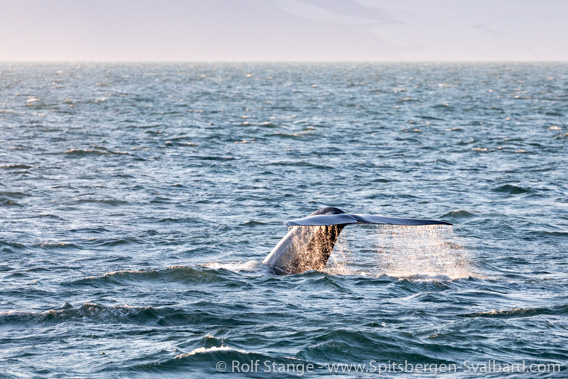
Isfjord has developed a sub-arctic oceanographical character in recent years,
something that has involved, for example, more whale sightings.
The photo shows a blue whale in Isfjord in September 2018.
This may currently be changing again – not permanently, however, but at least for a while. This is the result of oceanographical data that have recently been gathered by a team of UNIS scientists. The data are part of a long-term project to monitor the development in Isfjord. Frank Nielsen, professor for oceanography at UNIS, and his team have now published a report in Svalbardposten.
A key result is that there is currently much less mild, salt-rich Atlantic water in Isfjord than in previous years and the remaining volume of this water is largely at depths below 150 metres. In recent years, mild Atlantic water that drifts north with the Gulf Stream and reaches Spitsbergen’s west coast, where it is called the West Spitsbergen current, has had an increasingly strong influence in the fjords on the west coast. These have, as a consequence, lost much of their high-arctic character in terms of oceanography and biodiversity, rather becoming sub-arctic fjords instead. Important indicators include water temperatures, salt concentrations and species composition, especially of zooplankton.
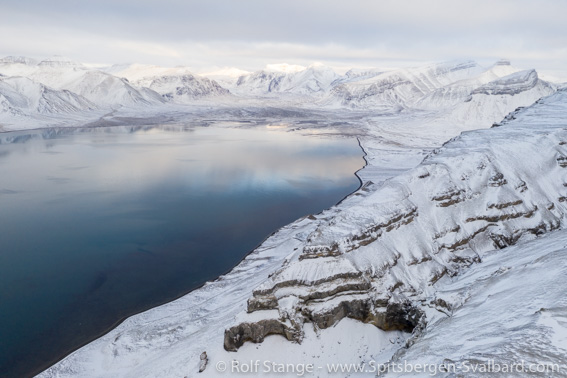
In the innermost branches, such as Petuniabukta (pictured here),
Isfjord’s high-arctic character has been retained so far.
Recent climatic changes have led to this development: part of the complex pictures are changed routes of low pressures, which now move north between Greenland and Spitsbergen, rather than moving east over the Barents Sea. The new route of the low pressures tends to push Atlantic water north and into Spitsbergen’s west coast fjords – an effect that can last over years, even though the low pressures disappear after a few days.
This year, however, regional weather patterns have been more like what they used to be in the past, with a more stable northerly influence which has, noticeably, led to few warm air incursions with melting temperatures in the winter, something that had become more common in the years before. Another result of the current air flow pattern in this sector of the Arctic is the less pronounced influence of temperate water masses in Spitsbergen’s fjords on the west coast. Other reasons for this current development may include the strong melting of local glaciers in the very warm weather of the last summer, which has led to a higher input of cold freshwater to the top layer of the fjord.
All this has now led to a change of species-composition of zooplankton back to a more high-arctic mixture. Arctic zooplankton is largely dominated by copepods. In recent years, the sub-arctic species Calanus finmarchicus has become dominant in most parts of Isfjord, but now it is mainly the high-arctic species Calanus glacialis that is dominant again.
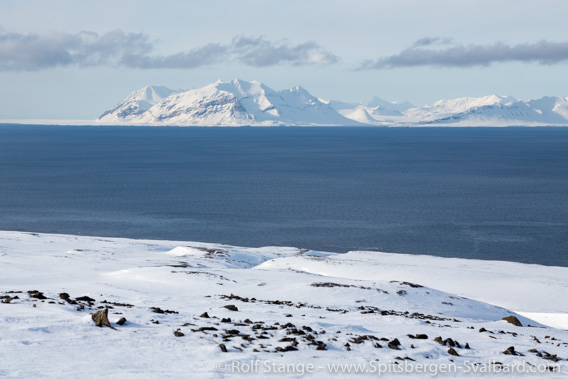
Currently, also central parts of Isfjord have a high-arctic oceanographical character again.
If this development is not soon terminated by strong low pressures associated with heavy storms from the “wrong” direction, then one of the results could be an ice cover that is more extensive and stronger than seen in recent years. Another result, if it lasts for a while, may be fewer whales and less cod in Isfjord next year.
But in case anyone is struck by the thought that climate change in the Arctic is called off now: this is not the case. As Nilsen puts it in his article, it is not a stable situation, but “rather a local dead-cat bounce within a warming Arctic” (original quote: Men en stabil situasjon er det ikke, det er mer som en lokal krampetrekning i et Arktis under oppvarming).
Record-low in sea ice cover in September
September is generaly the months with the lowest sea ice cover in the Arctic: the summer warmth has melted a lot of ice, and the cold of the winter is yet to come. So is is normal to expect little drift ice near Spitsbergen in September.
BUT – what does “little” drift ice mean? Even just a quick glance at the long-term development reveals a clear trend towards less and less ice. Arctic sea ice is monitored since 1979, and never has there been as little ice as in September, following a summer that has brought Longyearbyen record-breaking temperatures and a hot summer also elsewhere in the Arctic, such as Siberia, to mention just one example.
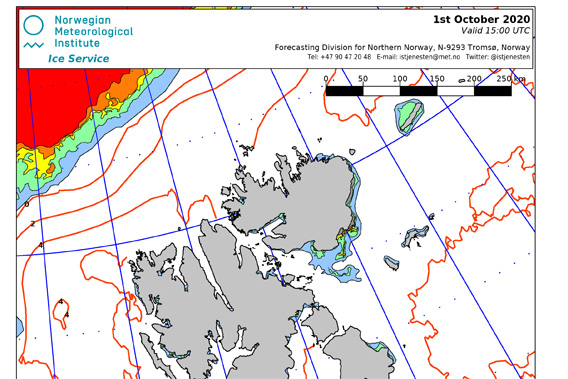
Ice chart of northern Svalbard as of 01 October: the “cold coast” (Svalbard) is currently completely free of ice.
© Norwegian Meteorological Institute.
According to a press release by the Norwegian Meteorological Institute, the monthly temperature average for September for the whole Arctic was 2.9 degrees above the long-term average, which is based on the reference period 1961-1990. When a new reference period will be introduced in 2021, based on the three decades from 1991 to 2020, the temperature deviations will appear less dramatic. But this will be no reason to declare the current climate change history, it will just be a different perception due to a new statistical reference period. An artefact, in other words.
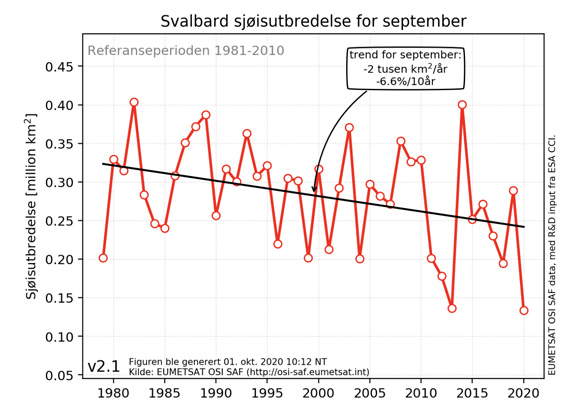
Changes of the sea ice cover in Spitsbergen from 1979 to 2020.
September 2020 has yielded a new all-time low.
© Norwegian Meteorological Institute.
Signe Aaboe, scientist at the Norwegian Meteorological Institute, does not doubt that the recent record values of arctic temperature and ice are due to man-made climate change.
Walk in the forest near Pyramiden
Tue
22 Sep
2020
Back to Spitsbergen’s beautiful aspects, which seem even remoter this year. It took several attempts to get to Pyramiden this time. In Spitsbergen, everything – well, almost – depends on the weather. The trip to Pyramiden by boat is more than 50 kilometres, and our boat wasn’t exactly Antigua or anything bigger. So, the weather should be ok. But we got our chance and arrived in Billefjord after a lunch break in Skansbukta.
Pyramiden
In Pyramiden, we could rely on a friendly welcome at Hotel Tulipan. A lot has happened there in recent years, the standard is improved – the bar is lovely and the food is good. The old, Soviet-style rooms are not available anymore, to my personal regret, but I guess that’s the walk of time. Some life has also returned to the Culture House. And they keep working here and there.
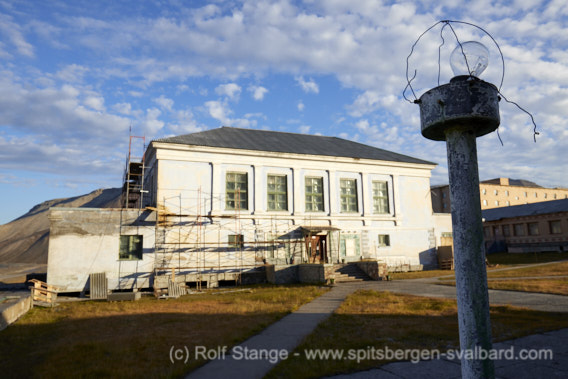
Things are happening in Pyramiden. Here, the old canteen is being renovated.
The devonian forest in Munindalen
But we wanted a walk in the forest. Well, in the Pyramiden area, you can not walk in a forest, but you can actually walk to a forest. In Munindalen, to be more accurate. This forest grew in the Devonian, more than 350 million years ago, probably in a river plain. Then, the trees were buried by sand and mud during a flood … and they became fossilised. Just as they were, in a vertical position, or “in situ”, as geologists say. One of the oldest forests in the world.
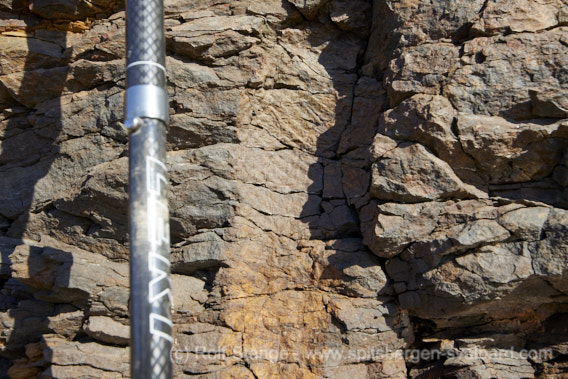
Imprint of a fossilised tree in Devonian rocks, Munindalen.
There were no trees before the Devonian. (And if you happen to find similar fossils in Pyramiden itself: they date to the Carboniferous, just as the coal, so they are a good bit younger than the Devonian trees in Munindalen). So it is worth getting wet and very cold feet as you have to step into the icy meltwater river because the outcrop is a little rockwall right next to it (or just bring your rubber boots, which we forgot …).
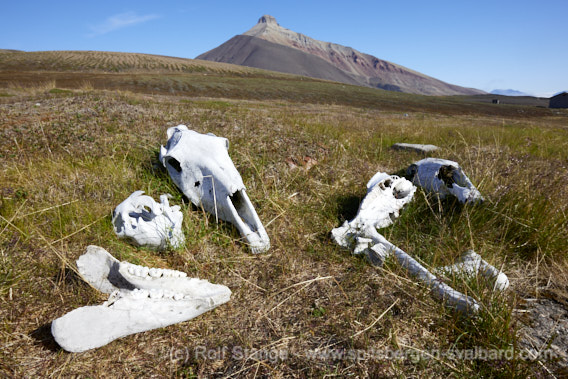
Even the reindeer were bigger than elsewhere in Pyramiden back then 😉
Seriously: they had horses.
Then, the fog came and settled in for several days, cutting Spitsbergen physicall off from the outside world (planes don’t land in Longyearbyen in dense fog). I spent most of the time on the return trip to Longyearbyen holding on to the GPS 🙂
If you would like to take a virtual trip to Pyramiden while it is hard to get there in real life – check the Pyramiden panorama pages, there is plenty of stuff there!
Gallery: Pyramiden and Munindalen
Some impressions from the trip from Longyearbyen via Skansbukta to Pyramiden and Munindalen.
- gallery anchor link: #gallery_1860
Click on thumbnail to open an enlarged version of the specific photo.
Longyearbyen is shrinking. And: the bank does not always win
Longyearbyen is changing during the corona crisis. The population is shrinking: 273 people have left since early March, according to official statistics. In addition comes an unknown number of people who have never registered or who did not give notice of their departure.
Many people lost their jobs when the corona crisis hit hard in spring and summer, and many can’t afford Longyearbyen’s high living expenses anymore and moved back to their countries of origin. The Spitsbergen treaty grants citizens from many countries free access, but the drawback is that Norway does not supply Svalbard’s non-Norwegian inhabitants with any social security regardless how long they have lived there. There was a one-time financial aid by the government in spring because of the corona situation, which also made it difficult for many to move away, but it was made clear that this programme would not be extended.
To many people’s surprise, the bank is also amongst the losers: the mother company, SpareBank Nordnorge, has decided to close 16 branch banks in north Norway. The company says that the reason is a changed customer behaviour as customers use the internet and do not go to the bank anymore, as Svalbardposten found out. It does not surprise that the decision is met with strong criticism in Longyearbyen.
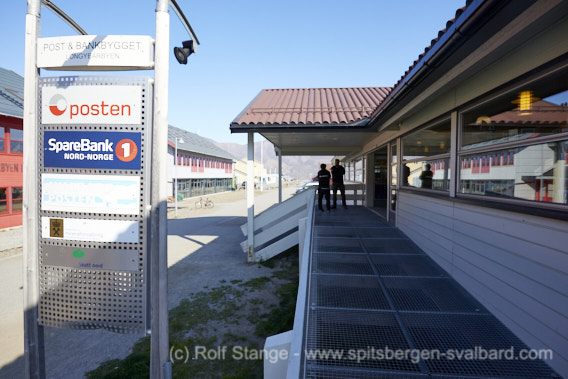
Post office and bank in Longyearbyen: the post stays, the Bank will close.
At least the post office will stay: will most post offices in Norway will be closed, the one in Longyearbyen is amongst the lucky few who will stay. In many places in Norway, postal services will only be available in shops and supermarkets in the future.
Polar bear dead in connection with scientific anaesthetisation
The series of sad news from Spitsbergen does not stop. On Wednesday, a polar bear died in connection with anaesthetisation for scientific purposes, according to the Sysselmannen.
The incidend happened in Wijdefjord during the routine autumn campaign to mark polar bears. In this process, bears are anaesthetised with tranquiliser guns from a helicopter to mark the animal and for other scientific purposes, usually including weighing and taking samples. The bear that died on Wednesday was bear number “30 or 31” of the current campaign.
So far it is only known that the bear did not survive. It is not yet known in public when in the process and how and why exactly he died. The Sysselmannnen opened a case to investigate the incident, so no further details have been released at the time of writing, for example concerning the question if a vet was present or not.
The routine to regularly anaesthetise a larger number of polar bears, involving a helicopter chase, has met criticism already before. According to Jon Aars, leading polar bear scientist of the Norwegian Polar Institute, it is common to “lose” 2 to 4 bears in 1000 anaesthetisations. This was the third time since 2003 that it happened to Aars, as he told Svalbardposten. According to Aars, marking bears is justified by the worth of the data thus obtained for scientists.

Meetings of humans and polar bears have already cost the lives of 4 bears and one person in Spitsbergen this year.
(The photo is symbolic: harmless find of an old polar bear skull in Hinlopen Strait).
It is already the fourth incident this year where a polar bear died during or after contact with people. There was, of course, the recent fatal attack of a bear on a man at the campsite near Longyearbyen, where a man and a polar bear died. A bear was shot by the police in early January although there was no immediate danger. And in late January, an anaesthetised bear died during helicopter transport away from Longyearbyen. It seems that the latter case has not been handled well and the incident attracted substantial criticism and raised a number of questions, for example if a vet should be present during such operations. It has not yet been revealed if a vet was present when the bear died in Wijdefjord on Wednesday.
Blog: trip to Svenskehuset at Kapp Thordsen
Mon
7 Sep
2020
After all the bad and even terrible news of the last couple of weeks, regarding a potentially deadly virus that keeps making everybodies lives difficult and a very deadly polar bear attack, it is easy to forget that Spitsbergen is still a beautiful place. It is time for a few photos to bring that back to mind.
It is a couple of weeks ago now, but that doesn’t matter. Isfjord was flat as a mirror, so we took the opportunity for a Zodiac tour from Longyearbyen to Svenskehuset at Kapp Thordsen.
Gallery: Svenskehuset
- gallery anchor link: #gallery_1850
Click on thumbnail to open an enlarged version of the specific photo.
I am not going to repeat the dramatic history of the “Swedish house” (Svenskehuset) at Kapp Thordsen here, as I have recently compiled a special side dedicated to Svenskehuset – including panorama images, as you may already have guessed. Have a look there if you are interested. I do recommend it. Finally getting these images was a strong motivation to take this trip.
And other than that, spending a long day in fine weather in a place like this, with fine views over Isfjord and all the big and small impressions of the scenery and the tundra, is an experience of the kind of which you (or, at least, I) just can’t get enough in life.
Regarding the small impressionf of the tundra: I have always experienced it as slightly disappointing to photograph the flowers. Because of the limited depth of field with macro photography, only a small part of the flower appears in focus. But today, photo technolocy enables us to take it a good step further. “Focus stacking” is the key. It requires some effort regarding preparations, equipment, photography and editing, but I think it is worth it in the end:
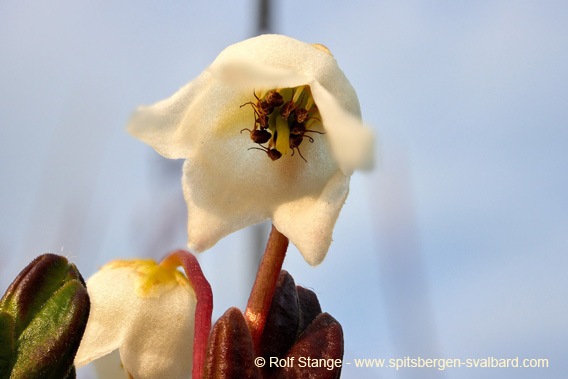
Arctic bell-heather near Svenskehuset.
Fokus-stacking makes it possible to have almost the whole flower in focus.
Phippsøya polar bear (MS Bremen, 2018): proceedings closed
The legal case of the polar bear that was shot in 2018 by crew members of the German cruise ship MS Bremen is closed, as the Sysselmannen informed in a press release on Friday.
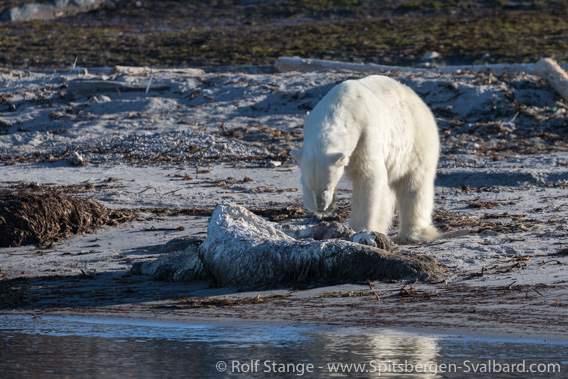
Polar bear on Phippsøya, feeding on a carcass.
It was most likely this bear that was shot
by crew members of MS Bremen in this place 11 days later.
The incidend happened on 28 July 2018, when 14 crew members of MS Bremen went ashore on Phippsøya, which belong to the islands of Sjuøyane, to prepare a landing for passengers. The group included the expedition leader, four polar bear guards, a photographer and other crew members. Two polar bears guards were soon sent out to check a part of the terrain that could not be seen from the landing area. They met the polar bear which had been hidden in a terrain depression. The bear attacked one person, who suffered head injuries. The bear did not stop the attack in spite of several warning shots being fired, so two persons fired in total three shots against the bear which killed him. The person who was attacked survived with minor injuries.
The photographer took photos of the event, which hence was well documented and easy to reconstruct.
Now the public prosecutor of Troms and Finnmark (north Norway) has decided to close the case. Shooting a polar bear is principally illegal and under punishment, but this was now officially found to be a case of self defence.
The case that had been opened against the company was also closed. Here, the companies safety routines had been investigated.
The investigations were finished in November 2019, but competence between different authorities was initially unclear and then the Corona crisis led to further delays.
Cruises in Spitsbergen now only with 30 persons in total
The Norwegian government has put more restriction on cruises in Spitsbergen: they are now only allowed for ships carrying 30 persons in total – that is, passengers and crew together. Day trips without overnight stays on board are not concerned by this restriction.
The government says that the difficulties a Covid-19 outbreak would bring on any larger ship would be difficult to control, hence the new restriction.
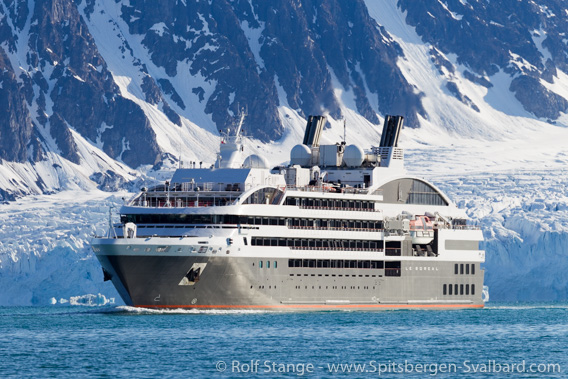
The Le Boreal (here seen in Liefdefjord in 2015) was one of only a few ships at all that have been able to do cruises this summer in Spitsbergen.
In June, the government opened the possibility to do cruises in Spitsbergen. But already then, restrictions such as a reduction of passenger numbers by 50 % kept many tour operators and ship owners from starting the season in Spitsbergen at all. After a Covid-19-outbreak on MS Roald Amundsen, also Hurtigruten stopped their expedition cruises completely. Beyond Hurtigruten and Ponant (Le Boreal), only a very few smaller ships were active with cruises over several days this year in Spitsbergen, such as Origo, who managed to do a handful of trips, and Cape Race, who just finished one successfully, only to cancel the rest of the season because of the recent introduction of quarantine for travellers from Germany. Cape Race will now try her luck in Scotland – fingers crossed!
The government has announced to re-consider this most recent restriction until 01 November. I would say: no rush. Then the season is over anyway, if it has ever happened in the ongoing Corona-year at all.
Wreck of Northguider removed
The wreck of the Northguider is now completely removed from Hinlopen Strait.
The shrimp trawler ran ground in Hinlopen, very close to the coast of Nordaustland, in late December 2018. The crew could be rescued by helicopter in a dramatic operation in very cold and stormy conditions and complete darkness. Later, environmentally dangerous materials including fuels and lubrication oils, paints, electrical equipment and fishing gear could be removed.

The wreck of the ship trawler Northguider and salvage vessels
in August 2019 in Hinlopen.
It was planned to remove the wreck during the summer of 2019, but difficult ice conditions delayed the operation and then it turned out that the wreck could not be removed in one piece because it was too heavily damaged.
Now the Northguider has been cut into several smaller pieces which could be taken to Norway. Divers confirmed that no wreckage is left on the sea flour either, according to the Sysselmannen.
Sysselmannen releases identity of victim
The Sysselmannen has released the identity of the man who was killed by a polar bear last night at Longyearbyen camping.
It was Johan Jacobus “Job” Kootte, 38 years old, Dutch citizen.

The site of last night’s tragic events.
Job worked this summer on the camping. It was his second season in this position.
The official release includes the information that Job was in his tent when he was attacked. The Sysselmannen has not yet released further details. Investigations are ongoing.
The other persons who were on the camping site at the time of the incident were not physically injured. They were seen by medical staff and psychologically taken care of in Longyearbyen. The Sysselmannen is interviewing them as witnesses.
Many, including the author of these lines, are shocked, and many thoughts are with Job, his family and close ones.
Man killed by polar bear near Longyearbyen
At 3.50 am, the alarm went in the Sysselmanne’s office (police) in Longyearbyen: a polar bear had attacked and injured a man at the campsite. The police and rescue forces brought the man to the hospital, where he was declared dead.
The Sysselmannen have not yet released the identity of the deceased person in their press release.
Two shots were fired at the polar bear by other persons. The bear was later found dead at the car park of the airport, only a few hundred metres away.

The site of last night’s tragic events.
All other persons who were present at the camping site were brought to a hotel in Longyearbyen. The Sysselmannen’s investigations are ongoing.
Polar bears had been seen a number of times in the vicinity of Longyearbyen, such as in Hiorthhamn and near Todalen (in Adventdalen). A female polar bear with a cub was sedated on Wednesday and flown out to the north side of Isfjord. Additionaly, a single bear had been seen a couple of times in Hiorthhamn and in Adventdalen.
News-Listing live generated at 2025/May/04 at 01:10:18 Uhr (GMT+1)
